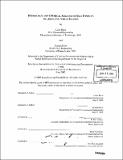Hydrologic and chemical analysis of salt ponds on St. John, U.S. Virgin Islands
Author(s)
Bossi, Liam, 1979-; Rose, Donald, 1978-
DownloadFull printable version (13.10Mb)
Other Contributors
Massachusetts Institute of Technology. Dept. of Civil and Environmental Engineering.
Advisor
E. Eric Adams and Peter Shanahan.
Terms of use
Metadata
Show full item recordAbstract
In order to assess the impact of human development on salt ponds, this study investigated the relationships between the chemistry of salt ponds and the hydrology of the surrounding area. Aspects of pond health such as nutrient levels, sedimentation parameters, and water quality indicators were analyzed in conjunction with development metrics, watershed descriptions, and runoff characteristics. Salt ponds were determined to be composed primarily of evaporated seawater. This determination was based on the outputs of hydrologic modeling, which predicted minimal inputs due to surface runoff, plus the results of regression analyses, which showed significant correlation between nutrient levels and salinity (R 2=0.885) and minimal deviation of measured nutrient concentrations from those predicted by evaporation. In addition, the feasibility of groundwater seepage measurement was investigated, as this seepage could play a key role in determining the role that human development may play in salt pond chemistry. Southside Pond, which met all the criteria necessary for seepage meter deployment, was analyzed for groundwater inputs; however, the information collected showed no evidence of significant groundwater inputs.
Description
Thesis (M.Eng.)--Massachusetts Institute of Technology, Dept. of Civil and Environmental Engineering, 2003. Includes bibliographical references (p. 81-83).
Date issued
2003Department
Massachusetts Institute of Technology. Department of Civil and Environmental EngineeringPublisher
Massachusetts Institute of Technology
Keywords
Civil and Environmental Engineering.